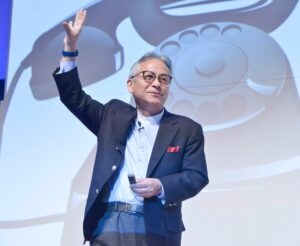MIT石井裕先生 特別講演 「Making Digital Tangible: The Battle Against the Pixel Empire」
| 日時 | 11月20日(金)10:00-11:00 |
|---|---|
| 概要 |
MITメディアラボ副所長の石井裕教授は、デジタル情報を実際に触れることができ、操作できるものにする「Tangible」の研究を長年続けてこられ、昨年、人間とコンピュータのインタラクションに関する学術分野に大きな貢献をもたらした人物に贈られる「SIGCHI LIFETIME RESEARCH AWARD」 をアジアで初めて受賞されました。
石井教授は、現代のテクノロジーは1年で時代遅れになるが、真のビジョンは100年を超えて続いていく、と語っています。 「真のビジョン」とは何か、サイエンス、アート、デザインがどのように関わり合い、未来への新しいビジョンを創っていくのか。 石井教授のモットーは、“Be Artistic and Analytic. Be Poetic and Pragmatic.” COVID-19で先の見えない今日を生きる我々へのヒントが、きっとこの言葉に、先生の講演に、隠れていると思います。 |
| 講演の詳細な内容紹介 |
<講演は日本語で行います> Tangible Bits seeks to realize seamless interfaces between humans, digital information, and the physical environment by giving physical form to digital information and computation, making bits directly manipulatable and perceptible both in the foreground and background of our consciousness (peripheral awareness).Our goal is to invent new design media for artistic expression as well as for scientific analysis, taking advantage of the richness of human senses and skills we develop throughout our lifetime interacting with the physical world, as well as the computational reflection enabled by real-time sensing and digital feedback. Radical Atoms leaps beyond Tangible Bits by assuming a hypothetical generation of materials that can change form and properties dynamically, becoming as reconfigurable as pixels on a screen. Radical Atoms is the future material that can transform its shape, conform to constraints, and inform the users of their affordances. Radical Atoms is a vision for the future of Human- Material Interaction, in which all digital information has a physical manifestation, thus enabling us to interact directly with it. I will present the trajectory of our vision-driven design research from Tangible Bits towards Radical Atoms, illustrated through a variety of interaction design projects that have been presented and exhibited in Media Arts, Design, and Science communities. These emphasize that the design for engaging and inspiring tangible interactions requires the rigor of both scientific and artistic review, encapsulated by my motto, “Be Artistic and Analytic. Be Poetic and Pragmatic.” |
| 講演者・出演者のプロフィール |
|
「申し込み」ボタンをクリックしてください。
来訪者登録がお済みでない方には、はじめに来訪者登録画面が表示されますので、
登録をして申し込みにおすすみください。
※定員になり次第締切となりますので、あらかじめご了承ください。
定員に達すると申し込みボタンがなくなります。
- 一覧へ戻る
- 受付終了





